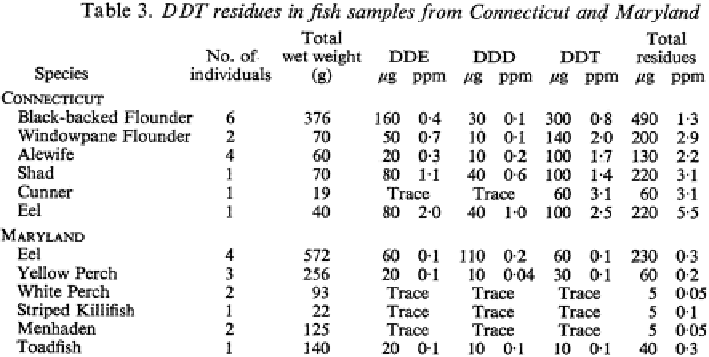Environmental Engineering Reference
In-Depth Information
Table 9
DDT in fi sh from Connecticut and Maryland. Table 3 in Ames (
1966
) reproduced with
permission
The Connecticut eggs contained an average of 5.1
ʼ
g/mL total DDT compared to
3.0
g/mL in the Maryland eggs. Ames (
1966
) also collected fi sh from osprey nests
in the Maryland and Connecticut studies (Table
9
).
The Connecticut fi sh residues ranged from 1.3 to 5.5 ppm total DDT, whereas the
Maryland fi sh residues ranged from 0.05 to 0.3 ppm total DDT. The differences
shown in DDT levels in fi sh diet, and in eggs and reproductive success between the
two colonies, is the fi rst report of this kind. The results provide the fi rst indications
of the relationship between levels of DDT in the fi sh diet, in the egg, and hatching
success. A crude biomagnifi cation factor for Connecticut osprey in 1963, based on
a weighted average fi sh residue of 2.1 ppm, is 5.7/2.1 = 2.7. For the Maryland data,
again using a weighted average fi sh residue, a crude estimate of the biomagnifi cation
factor from fi sh to egg is 3.3/0.23 = 14. The increase in biomagnifi cation factor
with declining fi sh residues could result from the slow equilibration between dietary
residues and adipose residues in the osprey and/or dietary sources higher in DDT
than the fi sh that were measured. Because of the second possibility, greater weight
should be given to fi sh data that were based on scraps from osprey nests. Even these
data are subject to limitations, however, because what is measured is what the
osprey didn't eat and often the remnants are dehydrated, resulting in higher residues
than would exist for fresh weight. Other investigators also documented the decline
in osprey populations.
Peterson (
1969
) reported on declining populations of ospreys in the United States
and Europe. The declines were mostly the result of hatching failure and were attrib-
uted to pesticides. Henny and Ogden (
1970
) reported on the breeding success and
status of osprey populations in seven states (Table
10
).
Reese (
1977
) reported on productivity for osprey all across the United States for
the period 1966-1974 (Table
11
).
ʼ

Search WWH ::

Custom Search